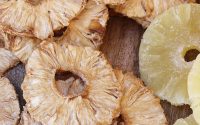Prunes vs. Plums:
Differences and History:
One question commonly asked is “aren’t dried plums called prunes?” The answer to that is yes and no; all prunes were plums but not all dried plums are prunes. That might seem confusing at first, but some of the main differences to distinguish between a plum and a prune are through their physical appearances. When fresh and ripe, the color of skin a majority of plums possess is a deep red while plums that become prunes have a purple or blue skin (01). Even the shape of each of them show their individuality as most varieties of plums are flattish shaped or round and prunes are oval shaped.
There are many varieties of plums worldwide also and the French plum is the one that dominates California (02). It makes a wonderful rich, sweet flavor of prune and is mainly used for being made into them. The Moyer is a bigger variety and is sweet and juicy when eaten fresh. It too makes an amazing prune seeing as the bigger size makes for a fluffier prune overall. Perhaps one of the absolutely significant differences between plums and plums that become prunes though is that most plums have a tart and sour skin while almost all future prunes have a sweeter skin.
The plum is world-renowned, with different varieties originating in European and Asian countries. Some of these varieties are said to have originated in the United States, but many made their way over from these other countries also (03). This took place when early settlers in New England introduced European plums to others (04). Japanese plums made their initial appearance in California around 1870 but didn’t set foot in San Joaquin valley until the 1960s (05). Seeing as the weather and cultivating conditions are spot on in the valley for the plum to flourish, this is where a good amount of plum acreage calls home.
- https://spoonuniversity.com/lifestyle/what-is-the-difference-between-prunes-and-plums
- https://healdsburgshed.com/2016/08/04/plum-varietals-history/
- https://www.reference.com/food/plums-come-11bea0b14a408b19
- http://www.agmrc.org/commodities-products/fruits/plums/
- https://apps1.cdfa.ca.gov/FertilizerResearch/docs/Prune_Plum_Production_CA.pdf


